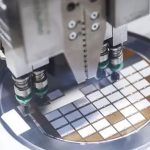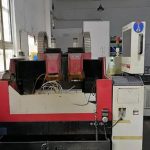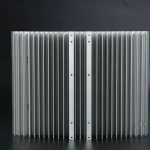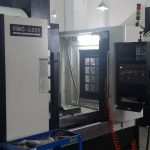Alkaline etching
1 main ingredients
Copper chloride, ammonia, amine chloride, a small amount of oxidants, corrosion inhibitors, etc.
2Application fields
Generally suitable for the production of outer circuit patterns of multi-layer printed boards or the production of direct etching patterns of microwave printed board negative plate method. Anti-etching. The metal resist layer of pattern electroplating such as gold, nickel, tin-lead alloy plating.
3 main features
1. The etching rate is easy to control, and the etching solution can achieve high quality metal etching in a stable state.
2. Large amount of dissolved copper
3. The etching solution is easy to regenerate and recycle, thus reducing pollution.
Key points to control: temperature, specific gravity and PH value
4Etching rate
About 1mil/min
5 main reaction mechanisms
copper etching reaction
Copper can exist in three oxidation states: metal CU on the plate, blue copper ions Cu(NH ~3~ )~4~ ^2+^ in the etching bath, and intermediate state cuprous ions Cu(NH ~ 3~ )~2~ ^1+^ . Metal copper CU can be oxidized and dissolved by Cu(NH ~3~ )~4~ ^2+^ in the etching bath, which completes the copper etching reaction. See the following reaction formula:
2Cu+2Cu(NH 3 )4Cl 2 →4Cu(NH 3 )2Cl(cuprous ion)
regeneration reaction
The intermediate cuprous Cu(NH 3 )2 ^1+^ generated in the above reaction formula is a light blue muddy precipitate with poor solubility. If it cannot be removed quickly, it will appear on the board. An obstacle to copper etching is formed on the surface, so it must be assisted by the etching sub-liquid (i.e. ammonia chloride and ammonia water) and a large amount of oxygen in the air, and it will continue to be oxidized into soluble Cu(NH 3 ) 4 ^2+^ after a series of reactions. , and then become an oxidizing agent for copper etching, and continue to react with the metallic copper CU on the board, so that the etching liquid can etch away more metallic copper CU. This is the recycling regeneration reaction of the etching liquid, see the following reaction formula:
4Cu(NH 3 )2Cl+4NH 3 +4NH4Cl+O 2 →4Cu(NH 3 )4Cl 2 +2H2O
net reaction
2Cu+4NH 3 +4NH4Cl+O 2 → 4Cu(NH 3 )4Cl2 +2H2O
Acid etching
1 main ingredients
Copper chloride, hydrochloric acid, sodium chloride or amine chloride
2 Applicable fields
Generally suitable for the production of inner circuit patterns of multi-layer printed boards and the etching of pure tin printed boards, or for full-board electroplating + dry film negative production processes
3 main features
The system, which is also widely used, is also relatively mature in terms of production capacity, recycling control and usage methods. However, due to the slow regeneration rate of ferrous chloride into copper chloride, the production rate is only half that of copper ammonia chloride. At the same time, it will corrode etching resists such as lead, tin, and pure tin, which are mostly used for inner layer and single-panel etching, and will produce chlorine gas when used. In order to pursue efficiency in pursuit of deadlines, many circuit board manufacturers use negative film + acid Etching process
4 Etching rate
0.5mil/min
5 Main reaction mechanism
Copper etching reaction:
Copper can exist in three oxidation states: metallic copper Cu0 on the board, blue ions Cu2+ in the etching bath, and less common cuprous ions Cu+. Metal copper Cu0 can be oxidized and dissolved by Cu2+ in the etching bath, see the reaction formula below
3Cu + 3CuCl2 → 6CuCl
Regeneration reaction:
Metal copper Cu0 is oxidized and dissolved by Cu2+ in the etching bath. The generated 2Cu+ is oxidized into Cu2+ by the oxidant and HCl automatically added to the etching bath through a series of reactions. These Cu2+ continue to react with the metal copper on the board. Cu0 reacts, thus allowing the etching solution to etch away more metallic copper Cu0. This is the recycling regeneration reaction of the etching solution, see the reaction formula below
6CuCl+NaClO3 +6HCl→6CuCl 2 +3H2O+NaCl
Net reaction:
3Cu + NaClO3 + 6HCl → 3CuCl2 + 3H2O + NaCl
Ferric chloride etching
1 main ingredients
Ferric chloride hydrochloric acid
2 Applicable fields
Generally suitable for single panel production
3 main features
Chlorine gas is required for recycling. It has shortcomings such as small capacity per unit volume, difficult control, and slow etching speed. It is mostly used by single panel factories.
4 key points of control
Specific gravity and pH value
5 Main reaction mechanisms
Etching mechanism:
**FeCl ^3^ +Cu→FeCl 2 +CuCl **
** FeCl 3 +CuCl→FeCl 2 +CuCl2 **
** CuCl 2 +Cu→2 CuCl **
5 Factors affecting etching rate
①The influence of Fe3+ concentration: The concentration of Fe3+ has a great influence on the etching rate. The Fe3+ concentration in the etching solution gradually increases, and the etching rate of copper accelerates accordingly. When the content exceeds a certain concentration, the etching rate decreases due to the increase in solution viscosity.
②Influence of etching liquid temperature: The higher the etching liquid temperature, the faster the etching rate. The temperature should be selected based on the principle of not damaging the resist layer, generally 40~50℃ is appropriate.
③Influence of the amount of hydrochloric acid added: Adding hydrochloric acid to the etching solution can inhibit the hydrolysis of FeCl3 and increase the etching rate. Especially when the amount of dissolved copper reaches 37.4g/L, the effect of hydrochloric acid is more obvious. However, the amount of hydrochloric acid added must be appropriate. If the acidity is too high, it will cause damage to the liquid photoresist coating.
④ Stirring of etching solution: The efficiency and quality of static etching are very poor. The reason is that during the etching process, there will be precipitates on the plate surface and in the solution, which will make the solution dark green. These precipitates will affect further etching.
Ammonium persulfate/sodium microetching
1 main ingredients
Ammonium persulfate sulfuric acid/sodium persulfate sulfuric acid
2 Applicable fields
Generally suitable for micro-etching production of inner and outer circuit patterns of multi-layer printed boards
3 main reaction methods
Na2S2O 8 +Cu→CuSO 4 +Na2SO4
4 Main features and precautions
The micro-etching system of sodium persulfate has replaced the ammonium persulfate system for 20 years. Since sodium persulfate does not produce ammonium-copper complexes, it makes wastewater treatment difficult, and it will form a more uniform roughened surface. Generally, the setting is about Sodium sulfate 100±10g/l, sulfuric acid about 1-3℅, temperature about 35℃±2℃, setting time about 60-120seconds, micro-etching depth about 0.375 to 2um, dissolved copper control amount <20g/l , the bite corrosion rate is about 0.5-2un/mil, but its disadvantage is that it cannot be recycled with a copper sulfate recovery machine. If the copper concentration is higher than the set value, the tank must be blocked.
The corrosion rate of sodium persulfate will increase from 0.2um/mil to 0.25um/mil because the copper concentration is higher than 0.75g/l. Therefore, the etching rate in sodium persulfate is difficult to control. In order to solve the problem of high corrosion rate Due to the changing properties, some manufacturers will develop stabilized persulfuric acid systems and add 5-15g/l stabilizer and bath liquid.
Hydrogen peroxide micro-etching
1 main ingredients
Hydrogen peroxide sulfuric acid
2 Applicable fields
Generally suitable for micro-etching production of inner and outer circuit patterns of multi-layer printed boards
3 main functions
Clean the board surface and roughen the copper surface
4 main reaction methods
Cu+H2O 2 →CuO+H2O
CuO+H2SO 4 →CuSO 4 +H2O
5 Main features and precautions
Hydrogen peroxide itself is an oxidizing solution, but because the nature of hydrogen peroxide itself is not stable enough, stabilizers and accelerators must be added, and the copper ions produced by etching are surrounded by sulfate radicals, and provide the sulfuric acid required for crystallization to facilitate corrosion. To increase the amount of copper and facilitate crystallization recovery, this etching temperature is generally 40°C. If the temperature is too low, the etching reaction will proceed too slowly, and if the temperature is too high, the etching factor will be affected. The concentration of hydrogen peroxide is set to 5-10℅, and the concentration of sulfuric acid is generally set to 10℅. The copper concentration in the etching solution will increase as the etching proceeds. It is generally limited to less than 50g/l. When the copper concentration in the bath solution increases, the hydrogen peroxide concentration will increase. The concentration will decrease, so controlling copper ions is a very important parameter in the microetching solution.
The disadvantage of hydrogen peroxide is that it is not a good stabilizer. Hydrogen peroxide will break the epoxy group due to excessive temperature. In addition, the catalytic action of divalent copper will produce water molecules and oxygen. In order to inhibit the decomposition of hydrogen peroxide, a stabilizer must be added to the solution. , the principle of its instability is due to the decomposition of hydrogen peroxide to produce free radicals, and the free radicals will accelerate the chain reaction, so adding a stabilizer can eat the free radicals and inhibit the occurrence of the decomposition reaction.
Link to this article:Common Etching Methods For PCB
Reprint Statement: If there are no special instructions, all articles on this site are original. Please indicate the source for reprinting:Alloy Wiki,thanks!^^










